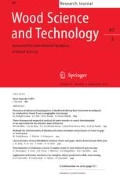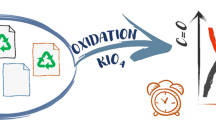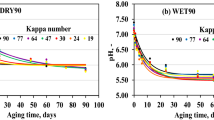Summary
The thermal stability of papermaking pulps under conditions of accelerated aging and at pyrolytic temperatures was examined. Degradation was found to be extremely complex and influenced by both the technical processes of papermaking and by the experimental methods used. At moderate temperatures, as used for accelerated aging, the folding endurance test was found to be a sensitive measure of degradation. Methods of reducing the variability of the test were considered, and a new technique capable of handling widely different results was developed and evaluated.
Several papermaking pulps were artificially aged and the resultant loss of strength attributed to the interaction between a gradual fiber strength reduction and a rapid increase in interfiber bonding. Excessive initial inter-fiber bonding decreased handsheet stability. Softwood sulfite and kraft pulps were more stable than a birch kraft pulp, but the behavior of sulfite pulps varied greatly. The presence of lignin or a high hemicellulose content was not of itself sufficient to cause rapid aging.
The pyrolytic behavior of pulps was investigated using thermogravimetric analysis. Papermaking pulps had mean pyrolytic activation energies between 30–45 kcal/mole. The activation energy decreased as the reaction proceeded. Correlation of these activation energies with the rate of loss of physical properties during accelerated aging was not good. The results indicated that the rate determining reactions for pyrolysis and for low temperature degradation are different but that the pyrolytic behavior is partially determined by the supramolecular structure. Empirical stability indices, based on both the integral and differential thermograms, were calculated, and these correlated well with the relative rates of loss of physical properties.
Similar content being viewed by others
References
Arney, J. S.; Jacobs, A. J. 1979: Accelerated aging of paper. TAPPI 62(7): 89–91
Arney, J. S.; Jacobs, A. J. 1980: Newsprint deterioriation. TAPPI 63(1): 75–77
Arney, J. S.; Novak, C. L. 1982: Accelerated aging of paper. TAPPI 65(3): 113–115
Barrow, W. J.; Sproull, R. C. 1959: Permanence in book papers. Science 129: 1075–1084
Browning, B. L.; Wink, W. A. 1968: Studies on the permanence and durability of paper. TAPPI 51(4): 156–163
Cardwell, R. D.; Lyon, L.; Luner, P. 1972: Evaluation of a fold test procedure for paper aging studies. TAPPI 55(2): 229–233
Cardwell, R. D.; Luner, P. 1976: Thermogravimetric analysis of pulp, part I. Wood Sci. Technol. 10: 131–147
Cardwell, R. D.; Luner, P. 1976: Thermogravimetric analysis of pulp, part II. Wood Sci. Technol. 10: 183–198
Cardwell, R. D.; Luner, P. 1977: Thermogravimetric analysis of pulps. In: Preservation of paper and textiles of historic and artistic value. Adv. in Chem. Series 164: 362–396
Church, R. W. (Ed.) 1959: Deterioration of book stock, causes and remedies. The Virginia State Library, Richmond, VA
Church, R. W. (Ed.) 1960: The manufacture and testing of durable book papers. The Virginia State Library, Richmond, VA
Dixon, Jr., P. H. 1962: An accelerated aging study of several writing papers. TAPPI 45: 753–760
Goldberger, J. H.; Rhyne, Sr., R. Y. 1966: A study of the fold test. TAPPI 45: 509–515
Graminski, E. L. 1970: The stress-strain behavior of accelerated and naturally aged papers. TAPPI 53: 406–410
Gray, G. G. 1969: An accelerated aging study comparing kinetic rates vs. TAPPI Standard 453. TAPPI 52: 325–334
Lee, S. B.; Feller, R. L. 1986: See Needles and Zeronian 1986, p. 329–339 and p. 377–386
Luner, P. 1969: Paper permanence. TAPPI 52: 796–808
Needles, H. L.; Zeronian, S. H. (Eds.) 1986: Historic textile and paper materials conservation and characteristics. Adv. Chem. Series 212, American Chem. Soc.
Spinner, I. H. 1962: Brightness reversion. TAPPI 45: 495–514
TAPPI Monograph Series 27, The bleaching of pulp, 1963. Chapt. 14, pp. 273–309
Williams, J. C. (Ed.) 1977: Preservation of paper and textiles of historic and artistic value. Adv. Chem. Series 164, American Chem. Soc.
Williams, J. C. (Ed.) 1981: Preservation of paper and textiles of historic and artistic value. Adv. Chem. Series 193, American Chem. Soc., 1981
Wilson, W. K.; Harvey, J. L.; Mandel, J.; Worksman, T. 1955: Accelerated aging of record papers compared with normal aging. TAPPI 38: 543–548
Wilson, W. K.; Hebert, R. L. 1969: Evaluation of the stability of record papers. TAPPI 52: 1523–1529
Author information
Authors and Affiliations
Additional information
A large part of this paper is based on the thesis of R. D. Carwell. Contributions were also made by L. Lyon and M. C. Varshney. This work was partially funded by the National Bureau of Standards
Rights and permissions
About this article
Cite this article
Luner, P. Evaluation of paper permanence. Wood Sci. Technol. 22, 81–97 (1988). https://doi.org/10.1007/BF00353231
Received:
Issue Date:
DOI: https://doi.org/10.1007/BF00353231




